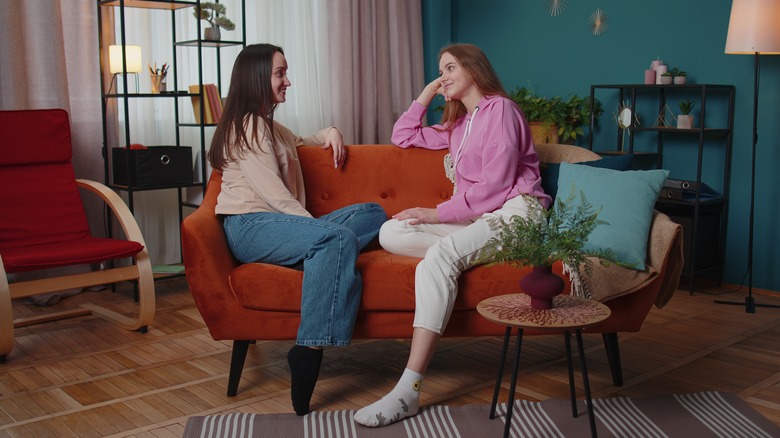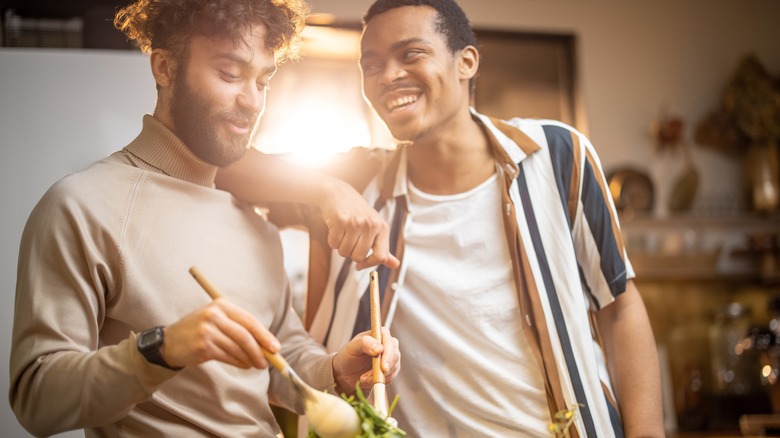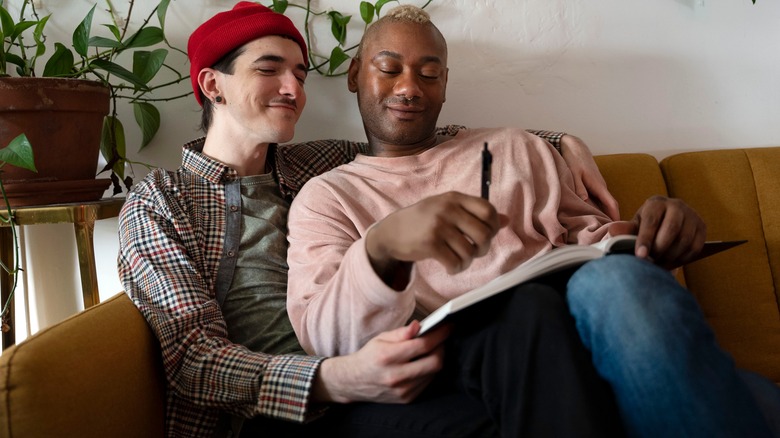The Importance Of Setting Intentions In A Relationship
Worldwide, there are about 323 million people actively using dating apps. Out of those users, according to Truly, 84% report that they are seeking a relationship. Sometimes, it can feel like everyone is looking for a relationship but no one really knows why they want one or what they want it to look like. This ambiguity often continues even after a relationship has formed. If there is a secret to developing a successful romantic partnership, it is setting intentions for both the relationship and yourself within it.
Operating from a place of reactivity rather than one of proactivity in a romantic relationship is a recipe for trouble, as detailed by Psychology Today. Intentionality can set you up for a relationship that progresses rather than becoming stagnant. It also allows you to become a more conscious, self-aware partner. Here's what it means to set intentions for your relationship and how to get started.
Identify what you want
Setting your intentions for your relationship should start before you ever even enter it. Wanting a relationship is one thing; knowing why you want one and what you want it to look and feel like is another. Think of the relationships that inspire you in your personal life or even in your favorite books and movies (via Bookish Santa). What is it that makes you notice that relationship? Mutual respect? Unconditional support? Mature conflict resolution?
Once you've identified the pillars you're looking for, you can keep them in mind during your early dating interactions. Visualize yourself experiencing a relationship that aligns with your intentions frequently. According to BetterUp, effective visualization should involve using all five senses to imagine the end result of living your intentions. If you don't see the signs of those intentions, you'll know it's time to move on from a prospective partner and continue searching for what you want from an intentional pairing. When you find one, it will have been worth the wait.
Create a relationship culture
After you find a relationship that aligns with your core intentions, it's time to expand those intentions to include your specific partner. The two of you will form your own ways of communicating and working through conflict and those ways will create the culture of your relationship (via Balance Health & Healing). Rather than letting habit, chance, or past trauma dictate this culture, come together to set intentions for it. How would you prefer to handle conflict and how would your partner? Are you both comfortable with good-natured ribbing or is one of you easily offended by being poked fun at?
Take the time to explore all aspects of your relationship and come together to set mutual intentions for what that relationship will look and feel like. Don't be discouraged if every intention doesn't match up perfectly from the beginning. If you can work together to meet in the middle, it is a great sign that you'll be able to work through any challenges your relationship may face in the future. As detailed by The Source, a healthy compromise is one made in good faith (not begrudgingly) by both parties.
Learn about each other
Before you set mutual intentions for your relationship, it can help to do a deep dive into learning about each other. This enables you to better understand where your partner is coming from on each issue and vice versa. Ask your partner to share with you the story of their childhood, their teenage years, and their previous romantic relationships. Then, share openly and vulnerably about your own. Knowing each other's triggers and the story behind them allows for empathy rather than frustration in challenging moments, as explained by MyTherapyNYC.
One way of gaining incredible insight into your partner is to discover their love language. Love languages are a notion created by Gary Chapman (via 5 Love Languages). They categorize partners by whether they most naturally give and receive love through word of affirmation, acts of service, gift giving, physical touch, or quality time. Knowing that washing the dishes when it's your turn is your partner's way of expressing their love when you're expecting gifts or physical touch can prevent a lot of friction. It can also be fun and freeing to practice expressing yourself through your partner's love language and they through yours.
Set specific goals
Once you and your partner have gotten to truly know each other and set intentions for the overall culture of your relationship, it's time to get specific. This will look different for every relationship and should take each partner's history and love language into account. If one of you experiences love through quality time, a specific intention to have a weekly date night—no matter what—would be highly recommended (via Women's Health).
You can also get specific about what you want your life as a couple to look like. If you're both feeling a little socially isolated since leaving the dating scene, set the intention to go out and look for other couples to befriend on a monthly basis or check out the app for that, Party of 4. Perhaps you share an interest and would like to turn it into a joint side hustle. Write out a detailed plan with specific steps to get you there. If you can visualize it, you can achieve it.
Conduct regular check-ins
Intentions should be specific, but they don't have to be rigid and unchanging. It is perfectly acceptable to change or let go of an intention if it isn't having the effect on your relationship that you thought it would. At least once each month, sit down with your partner and review your mutual intentions to assess whether they are improving the relationship and which ones are still important to you both. Be honest and upfront, always (via Couple Summit).
Humans are always growing and evolving and so are relationships, as reported by HuffPost. The most important part of keeping your intentional relationship healthy is setting and revising your intentions together. As long as you both agree on how you want your relationship to look, feel, and function, it doesn't matter how many times your intentions change. A healthy relationship ebbs, flows, and evolves along with the partners within it.





